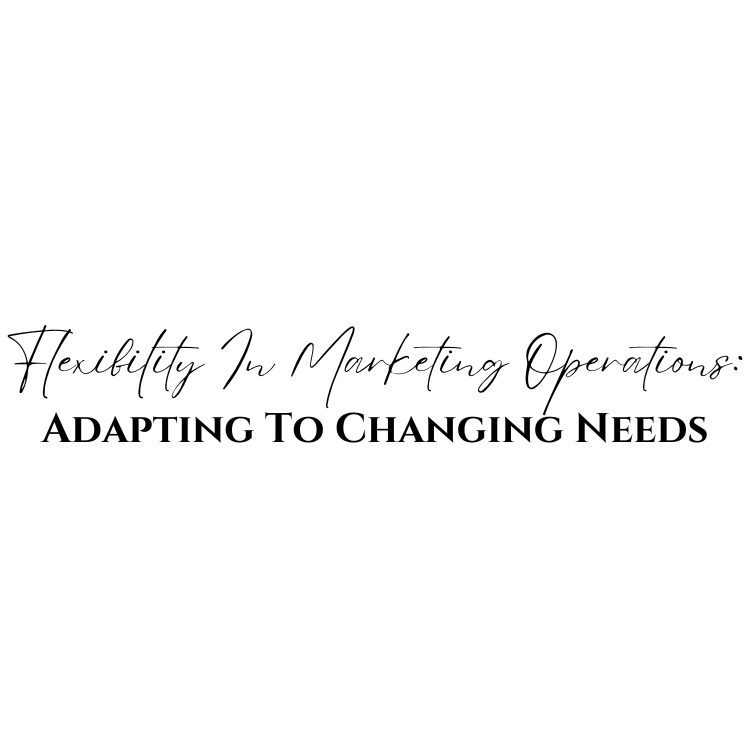Are you looking to stay ahead of the competition in today’s fast-paced market? Do you want to be able to adapt quickly and effectively to changes in consumer needs and emerging trends? Then it’s time to embrace flexibility in your marketing operations.
In a world where technology is constantly evolving, customer preferences are changing rapidly, and new competitors are emerging every day, flexibility has become a crucial aspect of successful marketing. Companies that can pivot quickly and efficiently have an advantage over those that are slow to adapt.
In this article, we’ll explore the importance of flexibility in marketing operations and share some strategies for adapting to changing needs. By staying agile and innovative, you can position yourself as a leader in your industry and meet the ever-changing demands of your customers.
Key Takeaways
- Balancing structure and flexibility is crucial for successful marketing operations.
- Experimentation and innovation are important for finding new ideas and approaches.
- Adapting to changing consumer preferences is essential for staying relevant.
- Tracking campaign performance and analyzing data is key to understanding the success of marketing efforts.
Importance of Flexibility in Marketing Operations
You need to be flexible in your marketing operations to keep up with changing needs and stay ahead of the game. Balancing structure and flexibility is crucial to ensure that your marketing operations remain effective while also being able to adapt rapidly.
While having a set structure can provide stability, it shouldn’t hinder your ability to make quick changes when necessary. Leveraging technology and automation is another key aspect of ensuring flexibility in your marketing operations. By automating repetitive tasks, you can free up time for your team to focus on more critical areas such as identifying emerging trends and shifting consumer needs.
Automation also allows you to respond more quickly, whether it’s updating content or launching new campaigns. Identifying emerging trends is essential for any successful marketer, but it requires an adaptable approach. With the ever-changing landscape of the digital world, marketers must be prepared for anything that comes their way.
Being agile and flexible in your marketing operations will enable you to pivot quickly whenever necessary, allowing you to stay one step ahead of the competition without missing a beat.
Identifying Emerging Trends
By keeping a finger on the pulse of consumer behavior, businesses can stay ahead of the curve and ride the wave of emerging trends, like how a surfer anticipates and catches a wave before it breaks. This requires constant data analysis and industry research to identify patterns and shifts in consumer preferences.
By leveraging this information, businesses can adjust their marketing strategies to meet changing needs and capitalize on new opportunities. To effectively identify emerging trends, businesses must analyze both qualitative and quantitative data.
Qualitative data refers to subjective information such as customer feedback or social media sentiment analysis. Meanwhile, quantitative data provides objective insights such as sales figures or website traffic statistics. Combining these two types of data enables businesses to create a more complete picture of current market trends which informs effective decision-making.
In addition to analyzing data, conducting industry research is also crucial for identifying emerging trends. This involves monitoring competitors’ activities and staying up-to-date with advancements in technology that may impact the industry landscape.
Keeping abreast of these changes allows businesses to adapt quickly and remain competitive in an ever-changing market environment. With an understanding of emerging trends through careful analysis of both qualitative and quantitative data as well as thorough industry research, businesses can be better equipped to make strategic decisions that drive growth.
Collaboration and communication within the marketing team play a critical role in implementing these strategies effectively without sacrificing agility or flexibility.
Collaboration and Communication within the Marketing Team
Effective collaboration and communication among team members are crucial for achieving marketing goals and staying ahead of the competition. With the increasing use of virtual tools and remote work, it’s important to establish clear channels for communication and collaboration. This includes regular check-ins, video conferences, and using project management software to track progress. By leveraging these tools effectively, teams can stay connected regardless of location.
In addition to virtual tools, cross-functional training, and skill sharing are key components of successful collaboration within a marketing team. Encouraging team members to learn about different areas of marketing can help break down silos and foster a culture of openness. Providing skill-sharing opportunities through workshops or mentorship programs can also lead to new ideas and approaches that benefit the entire team.
Overall, effective collaboration and communication within a marketing team are essential for success in today’s fast-paced business environment. By utilizing virtual tools and promoting cross-functional training, teams can stay agile while adapting to changing needs. This approach sets the stage for experimentation and innovation that will enable companies to maintain their competitive edge in the marketplace.
Experimentation and Innovation
As a marketing professional, you understand the importance of staying ahead of the curve in an ever-evolving industry. Experimentation and innovation are key to finding new ideas and approaches that can give your brand a competitive edge.
By encouraging a culture of innovation within your team, you can foster creativity and drive results through constant experimentation with new marketing strategies and technologies.
Trying New Ideas and Approaches
Exploring new avenues and taking risks is like adding spices to a recipe – it can enhance the flavor of marketing operations. Risk-taking strategies are essential to keep up with dynamic market trends and customer preferences.
By trying new ideas and approaches, you can create a unique brand identity that stands out from your competitors. Customer feedback is a valuable tool to understand what works and what doesn’t in your marketing campaigns. It helps you identify areas for improvement and refine your approach accordingly.
When experimenting with new ideas, it’s important to keep an open mind and be willing to pivot if necessary. This flexibility allows you to adapt quickly to changing needs and stay ahead of the curve.
Encouraging a culture of innovation requires a willingness to take calculated risks and embrace change as an opportunity for growth. By fostering an environment where experimentation is encouraged, you can unlock new potential in your marketing operations.
Encouraging a Culture of Innovation
To create a culture of innovation, you can foster an environment where team members are encouraged to brainstorm new ideas and take calculated risks, resulting in a creative and dynamic workplace. Promoting creativity and nurturing ideas can lead to breakthroughs that set your business apart from competitors. Encouraging employees to think outside the box helps them to see problems from different angles and identify unique solutions.
One way to empower employees and foster growth is by providing regular training opportunities. This allows individuals to develop new skills and gain confidence in their abilities, leading to increased engagement and motivation. Additionally, providing resources for experimentation and prototyping can help team members test out new concepts without fear of failure. By creating a supportive environment that values innovation, you can encourage your team to be agile and responsive in meeting changing needs.
Agility and Quick Response Time
You need to prioritize agility and quick response time in your marketing operations if you want to stay competitive in today’s fast-paced market. According to a study by Forbes, companies that can respond quickly to changing customer needs are 60% more profitable than those that can’t.
Real-time decision-making is crucial for success in the modern business landscape. By staying ahead of the competition and being agile, you can ensure that your marketing efforts are always relevant and impactful.
To achieve agility, it’s important to have a flexible organizational structure that allows for quick decision-making and execution. This means creating a culture of collaboration where different departments work together seamlessly towards common goals. It also means investing in technology solutions like automation tools and data analytics platforms that enable real-time monitoring of trends and insights.
Being agile doesn’t just mean reacting quickly; it also involves anticipating changes before they happen. By constantly analyzing data and measuring campaign performance, you can identify areas for improvement and make adjustments proactively.
Measuring and analyzing results is the next step toward optimizing your marketing operations for maximum impact. With the right approach, you can achieve outstanding ROI while keeping up with an ever-evolving market environment.
Measuring and Analyzing Results
Measuring and analyzing results is the key to understanding the success of your marketing efforts and improving future campaigns. The first step in measuring your campaign’s success is by tracking conversion rates. You can determine how effective it truly is by monitoring how many people are taking action after seeing your ad or message. This helps you understand which areas need improvement and which strategies work.
Secondly, customer feedback is an essential factor in analyzing the performance of your marketing efforts. Collecting customer feedback allows you to understand their preferences, pain points, and expectations better. This information can help you make improvements that will resonate more with your target audience.
Use data analytics tools to understand patterns in customer behavior and buying habits. These insights can provide a clear picture of what works best for your customers, helping you tailor your campaigns accordingly. By keeping track of these metrics regularly and making necessary adjustments based on them, you’ll be able to adapt quickly to changing consumer preferences.
With a deep understanding of how well your current marketing strategy performs from measuring its results and gathering feedback from customers, it’s time to take a closer look at adapting to changing consumer preferences.
Adapting to Changing Consumer Preferences
Now that you’ve learned about measuring and analyzing the results of your marketing efforts, let’s talk about the importance of adapting to changing consumer preferences.
In today’s fast-paced and constantly evolving market, it’s crucial to keep up with your consumers’ needs and wants to stay relevant.
One way to do this is through personalization strategies. By tailoring your marketing messages and offerings to individual consumers based on their preferences and behavior, you can create a more personalized and engaging experience for them. This not only helps build customer loyalty but also increases the chances of conversion.
To effectively implement personalization strategies, it’s important to conduct a thorough consumer behavior analysis. By tracking their interactions with your brand across different channels, you can gain valuable insights into what they like or dislike about your products or services. This information can then be used to deliver targeted messaging that resonates with them on a deeper level.
Overall, being able to adapt quickly and effectively to changing consumer preferences is key in today’s marketing landscape. By embracing personalization strategies and utilizing consumer behavior analysis, you can stay ahead of the curve and continue meeting the evolving needs of your customers.
Conclusion
Congratulations, you’ve learned about the importance of flexibility in marketing operations.
As a marketer, you must always be willing to adapt to changing needs and emerging trends. This requires collaboration and communication within your team, as well as experimentation and innovation to stay ahead of the curve.
Remember, agility and quick response time are key factors in today’s fast-paced market. It’s crucial to measure and analyze results to make informed decisions and adjust your strategy accordingly.
By staying on top of consumer preferences, you can tailor your approach and ensure that your marketing efforts remain relevant.
In conclusion, embracing flexibility in your marketing operations will help you stay competitive in an ever-changing landscape. As the famous saying goes, “The only constant in life is change.” Don’t be afraid to try new things and take risks – it just might lead to success beyond your wildest dreams!
Frequently Asked Questions
How can marketing teams ensure that their experiments and innovations align with the overall business strategy?
Like a GPS guiding your journey, strategy alignment is crucial for agile marketing. Set goals and experiment accordingly to ensure that innovation drives growth while staying true to the overall business strategy.
What are some examples of successful collaboration and communication within marketing teams?
To foster a collaborative culture, use communication tools to share ideas and feedback. Successful marketing teams prioritize transparency and inclusivity, encouraging diverse perspectives that lead to innovative solutions.
How can marketing teams effectively measure and analyze the success of their flexible strategies?
To effectively analyze the success of your flexible marketing strategies, use data-driven insights to measure performance metrics such as engagement rates, conversion rates, and ROI. Continuously improve campaigns based on these metrics to drive innovation and achieve greater results.
What are some common challenges that arise when adapting to changing consumer preferences, and how can they be overcome?
Adapting to changing consumer preferences can be challenging. Customer feedback is crucial, and an Agile methodology can aid in quick adjustments. Stay flexible and open-minded to new ideas to overcome obstacles.
How can marketing teams balance the need for flexibility with the need for consistency in branding and messaging?
You can balance creativity and maintain standards by implementing a clear brand strategy that allows for flexibility within defined guidelines. Use data to inform decisions and encourage cross-functional collaboration to ensure consistency while adapting to changing needs.





